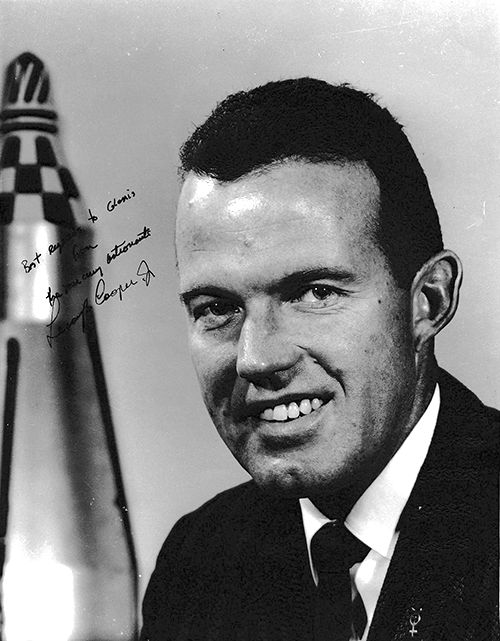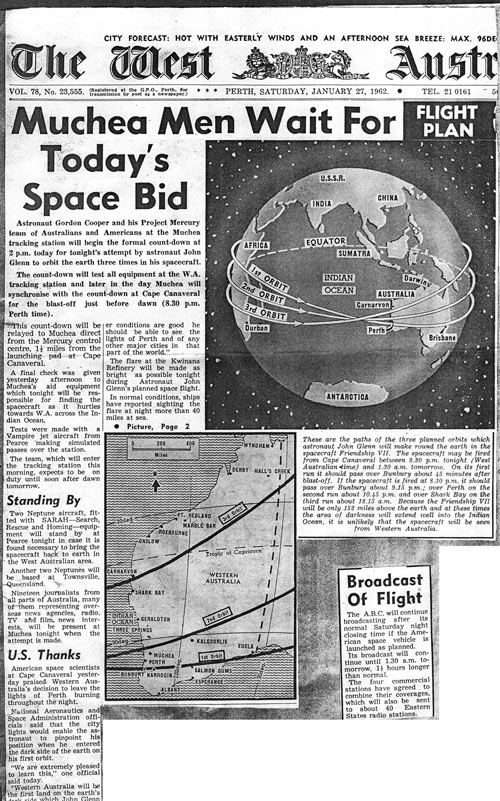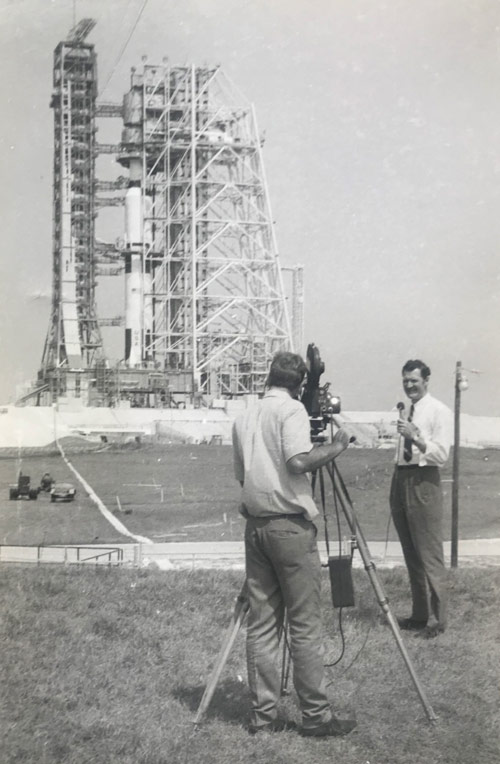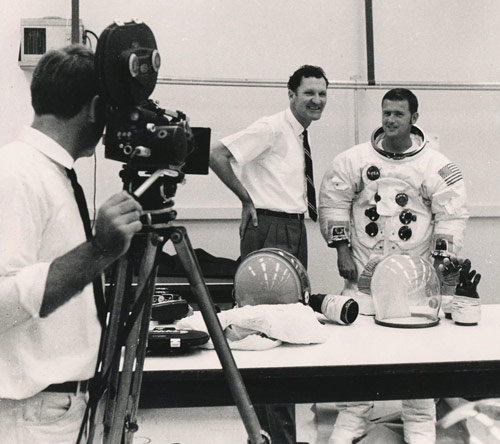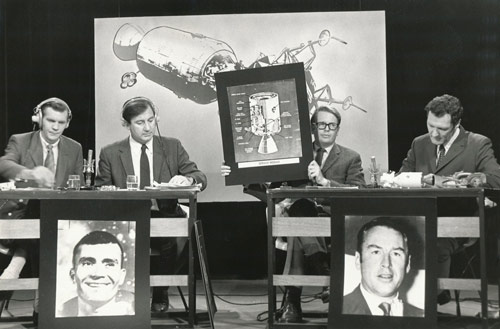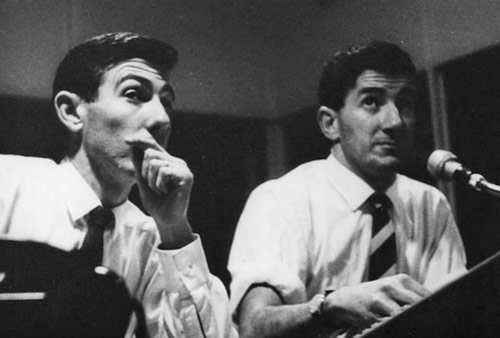by Darcy Farrell, founding News Editor for TVW Channel 7, Perth
|
Darcy Farrell served as the founding News Editor at Western Australia’s first television station, TVW7, from 1959 to 1976.
In that role he took a keen interest in the US space program, and was one of the journalists stationed at Muchea for Friendship 7 in early 1962.
Image: Ken McKay, WA TV History. |
Apart from reading Buck Rogers comics as a kid, my interest in space was triggered by Sputnik.
I was travelling down the Persian Gulf when I first heard it. I was laying on my back on the deck of a ship, hopeful that on that starry night I would see the satellite. I had been an early star gazer because there was an observatory with a very large telescope not far from my home in Cook’s Gardens [Wanganui, New Zealand]. I learnt that Sirius was the brightest star in the heavens and Alpha Centauri was the closest to earth.
I never did see Sputnik. I heard the beep which was being replayed often on radio.
That was 1957 and I had been working in newspapers in London.
I travelled from the Gulf and ended up at The Straits Times in Singapore before returning to WA Newspapers in Perth.
WAN obtained the first TV licence and I was the first News Editor.
They were the days when there were only a couple of communications satellites, Telstar being one of them. We had to go to the Perth Airport to wait for aircraft to arrive with our news film. A well-known import-export agent named Hec Foley handled the Customs side of things. We subscribed to CBS and BBC before switching our European and UK coverage to ITN.
My ‘space knowledge’ was magnified when I saw JFK challenge his fellow Americans to put a man on the moon and ‘return him safely to earth’.
Yuri Gagarin’s single orbit had, to coin a colloquial term, ‘put a rocket under’ the Americans and they responded with 1000 per cent effort.
The seven Mercury astronauts were selected and if you read their CVs you can see why. They were among the most brilliant aviators in the American forces.
I’m going by memory but I think they were –
Alan Bartlett Shepard, Virgil I Grissom, John Herschel Glenn Jnr, Malcolm Scott Carpenter, Wally Marty Schirra, Leroy Gordon Cooper, Donald Kent Slayton.
Glenn had already made a name for himself as the Marine Corps pilot who had raced his jet fighter across the United States. The others were all top students during their academy years.
In addition, others were taking the X-15 rocket plane to new speeds and into weightlessness.
The US space program got off to a bad start with numerous rockets exploding on the launch pad or soon after takeoff.
As the Mercury Seven went into training, NASA announced the flight program which included the setting up of a communications station in WA. Muchea, just north of Perth, was the site selected. It is about halfway or 45 minutes approximately from Cape Canaveral on the orbit around the earth.
As Muchea was being built, Mercury was having its day of destiny, as one writer described it.
Shepard in Freedom 7 became the first astronaut in space as he made a short sub-orbital flight into the Atlantic.
Grissom was next in a similar shot, but the fact that his capsule sank after splashdown was to become a harbinger of his ultimate fate.
Our excitement grew when Gordon Cooper arrived in Perth.
|
Autographed photo of astronaut Leroy Gordon Cooper, Capcom at Muchea for Friendship 7, February 1962.
Given to Glenis Austin (nee Wilkerson), scan by Jenni Whyatt. |
At his first media conference he outlined the details of the upcoming triple orbit of the earth to be flown by Colonel Glenn in his Mercury capsule Friendship 7.
Cooper and other astronauts were sent to stations around the world so Glenn would have familiar colleagues as he communicated with the ground on his historic mission.
I attended a number of Cooper interviews. He was both personable and cooperative with our media.
West reporter Bill King asked him if Colonel Glenn would be able to see the lights of Perth. When Cooper told us the lights would be visible from Friendship 7 I then asked if it was important to which he answered ‘no’.
However, the wily Bill King wrote that Perth people should switch on their lights to help guide Glenn across the heavens. He suggested to a reluctant Lord Mayor Harry Howard that the Perth City Council should switch on street lights and every other venue which would illuminate our landmark.
Gordon Cooper didn’t buy into the idea. He was too busy preparing at Muchea where Lewis Wainwright, the officer in charge, had drilled a tightly knit and disciplined team of no more than 20 to carry out the duties which would help Colonel Glenn to fly into history. It was fortunate that Gordon Cooper was there because Lewis, as I understand it, was often overruled by public servants from the Department of Supply. Cooper obviated this by his seniority.
If I remember correctly Glenn was in the capsule stop the Atlas rocket for some hours before the mission was scrubbed because of poor weather and technical niggles. It was scrubbed three times. When he eventually flew, everything went smoothly.
|
Dr. Warren Bishop gave this front page of The West Australian, January 27, 1962 to Hamish Lindsay. The launch was delayed more than once, and Glenn finally flew around the Earth on February 20.
There was much excitement about the coming flight.
© The West Australian. Scan by Colin Mackellar. |
As the tiny Friendship 7 crossed the Indian Ocean and headed our way Gerry O’Connor’s voice could be heard inside the Muchea Station.
‘Friendship 7, Friendship 7...this is Muchea Comtec’. Gerry repeated the call sign and soon above the crackle of static we heard the voice of Colonel Glenn.
As he flew overhead, our studio cameras at Tuart Hill were aimed at the tiny spec wobbling across the sky 130 miles high.
At Muchea we were kept about 100 metres from the main block where the action was taking place. Cooper had briefed Colonel Glenn about the controversy on the ground about switching on the lights. Glenn saw the stream of light and ‘Gordo’ told him he was seeing Perth and the burnoff flame from the oil refinery at Kwinana. The spaceman thanked the people of Perth.
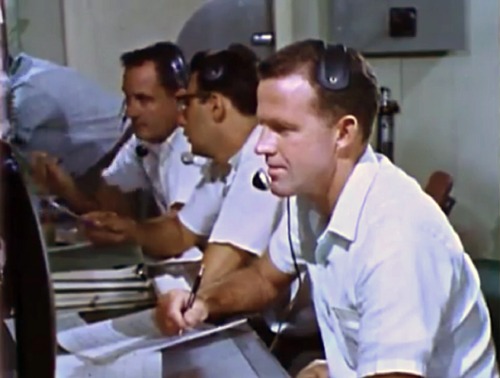 |
Muchea CapCom, Astronaut Gordon Cooper, speaks with John Glenn as he passes overhead.
|
|
Dr. Warren Bishop gave this front page of The West Australian, January 28, 1962 to Hamish Lindsay. Scan by Colin Mackellar.
While Perth lit up, Glenn’s launch was delayed. © The West Australian. |
From that day on, we were known as the City of Light and within a couple of days the Oklahoma Gas and Light company took a full page ad in The West Australian thanking Perth for being the City of Light.
Bill King became a local hero and was eventually appointed our information officer at WA’s office in his native England.
Following the success of Friendship 7, Colonel Glenn and family and colleagues were given a ticker tape reception in New York. Lord Mayor Howard was a guest there.
Colonel Glenn went on to be a Senator and Presidential candidate. He flew in space again as an elder citizen to test the impact of space travel on the aged.
Deke Slayton was the next astronaut to be the communicator at Muchea and I did a lengthy interview with him in which we used USIS photos and posters to illustrate the intricacies of Project Mercury. Slayton became chief astronaut but couldn’t fly because of a health defect. However, towards the end of the Apollo program he was in the crew for as module pilot.
|
Autographed photo of astronaut Deke Slayton – Capcom at Muchea for MA-7, May 1962.
Given to Glenis Austin (nee Wilkerson), scan by Jenni Whyatt. |
TVW7 sent Journalist Syd Donovan and cinematographer Alex McPhee to Cape Canaveral for the Apollo 11 Mission to the moon. Their coverage included rare interviews and vision not obtained by any other Australian media group.
Because of Perth’s City of Light status, NASA and its principals gave Syd and Alex access to areas and personnel not usually available.
|
TVW7 Perth Cinematographer Alex McPhee and Senior Journalist Syd Donovan report from Pad 39A at Cape Kennedy, three days before the launch of Apollo 11.
Photo with thanks to Alex McPhee. |
|
Alex McPhee (left) and Syd Donovan film a report on the space suits worn by the Apoillo 11 crew.
Photo courtesy Channel 7 Perth archives. With thanks to Janine Vidot, Seven Perth. |
Yes, I remember Muchea and Projects Mercury, Gemini and Apollo well.
But when I was production switching channel Seven’s walk on the moon by Neil Armstrong I kept asking myself how they did it. The fragility of the equipment and the timing and the need for perfection was a tribute to all concerned.
Apollo 13 showed that luck and Providence were with the astronauts. Gus Grissom and his two co-pilots died in their Apollo Capsule while training on the ground. Neil Armstrong ejected when flying the model of the lunar landing vehicle. He escaped when the machine burst into flames.
|
TVW7 Perth put great effort into covering the Apollo 13 emergency in April 1970. Syd Donovan is at right.
Photo courtesy Channel 7 Perth archives. With thanks to Janine Vidot, Seven Perth. |
On that February night in 1961 at Muchea we had no idea that we were witnessing the beginning of a great new chapter in space history. Few events in the annals of flight have been more important.
|
Darcy Farrell (right) and colleague Ross Cusack.
Photo courtesy Channel 7 Perth archives. With thanks to Janine Vidot, Seven Perth. |
|
Alex McPhee.
Photo courtesy Channel 7 Perth archives. With thanks to Janine Vidot, Seven Perth. |
Back to
the main Muchea page.



